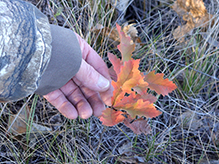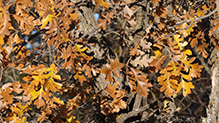Bur oak
(Quercus macrocarpa var. macrocarpa)
Conservation • Wetland • Description • Habitat • Ecology • Use • Distribution • Taxonomy
Conservation Status |
|||
| IUCN Red List | not listed |
||
| NatureServe | N4N5 - Apparently Secure to Secure SNR - Unranked |
||
| Minnesota | not listed |
||
Wetland Indicator Status |
|||
Great Plains |
FACU - Facultative upland |
||
Midwest |
FAC - Facultative |
||
Northcentral & Northeast |
FACU - Facultative upland |
||
Description
Bur oak is a slow growing, long-lived, deciduous tree rising on a single trunk from a taproot and widely spreading roots. The root system is massive—the weight of the root system equals the weight of the above-ground growth of the tree. In Minnesota mature trees are usually 50′ to 80′ tall and up to 43″ in diameter, though individuals can reach over 100′ in height.
In open areas with deep soil the trunk is straight and is distinct to the upper crown. In less favorable conditions the trunk splits into heavy, gnarled, ascending branches.
The branches are ascending to spreading; ascending in the upper part of the crown, nearly horizontal in the lower part. The crown of young trees is tall and oval with a rounded top. In open areas the crown of mature trees can be very broad.
The bark on young trees is rough. On mature trees the bark is thick and ashy gray, with deep furrows and ridges that are broken into irregular, dark gray scales.
The twigs are stout, yellowish- to grayish-brown, and slightly hairy. Branchlets often develop flat, radiating, corky wings. Terminal buds are reddish-brown, hairless, round, 1 ⁄16″ to ¼″ long, and blunt at the tip. Lateral buds are 1 ⁄16″ to 3 ⁄16″ long and are closely appressed to the twig.
The leaves are alternate, leathery, 4⅓″ to 8″ long, 2¾″ to 6″ wide, and inversely egg-shaped in outline but otherwise variable in shape. They are on hairy leaf stalks that may be ⅜″ to 1 3 ⁄16″ long, but are usually ⅝″ to 1″long. The leaf blade is rounded or wedge-shaped at the base. There are 2 to 6 large, irregular, rounded, primary lobes and 2 to 10 smaller, rounded, secondary lobes or rounded teeth per side. The deepest sinuses, near the center of the blade, are usually very deep, extending 50% to 90% of the way to the midvein. Most leaf blades are fiddle-shaped, with a broad, expanded, shallowly lobed upper half (terminal lobe) above a deep sinus and a few short lobes on the lower half. The upper surface is dark green, shiny, and hairless or sparsely hairy. The lower surface is pale green or gray and densely hairy with short, appressed, star-shaped hairs, making it velvety to the touch.
Male and female flowers are borne on the same tree. Male flowers are in slender, ¾″ to 2⅜″ long catkins that hang downward from buds on branchlets of the previous year. Female flowers appear in clusters of 1 to 3 on a short stalk rising from leaf axils of the current year’s twigs. The flowers appear after the leaves in May to early June.
The fruit is a large, narrowly egg-shaped to flattened egg-shaped, 9 ⁄16″ to ⅞″ long, ⅜″ to ⅝″ wide acorn. This is the largest acorn of any of the native oaks. They are in clusters of 1 to 3 acorns on a short, stout stalk. A scaly, dome-shaped cup encloses ½ to ⅞ or more of the lower part of the nut. There is a conspicuous fringe of soft, curly, 3 ⁄16″ to ⅜″ long awns along the rim of the cup, which gives this tree its common name. The inside of the acorn cup is uniformly hairy. The nuts ripen in early August to early mid-September of the first year. It tastes sweet or slightly bitter.
Height
50′ to 80′
Record
The champion bur oak in Minnesota is on private property near Rochester, in Olmsted County. In 1999 it was measured at 68′ tall and 277.5″ in circumference (88.3″ in diameter), with a crown spread of 155′.
Flower Color
Green
Similar Species
Bur oak (Quercus macrocarpa var. depressa) is found along the western margin of the Great Plains. It is a shrub or small tree no taller than 16′ that occurs on bluffs and hillsides. The acorns are smaller with smaller, less fringed cups.
White oak (Quercus alba) bark is thin and fine-textured. The branchlets do not have corky ridges. The lateral buds diverge from the twig. The leaves are more uniformly lobed and never has a large terminal lobe. The underside of the mature leaf is hairless or has a few hairs along the main veins. The acorn cup encloses only the lower ¼ to ½ of the nut, and does not have a fringe of awns along the rim.
Habitat
Moist to wet; drought tolerant. Prairie borders, dry hillsides, river valleys, savannas, bottomlands. Full to partial sun.
Ecology
Flowering
May to early June
Pests and Diseases
Jumping oak gall wasp (Neuroterus saltatorius) appears as small, BB-sized growths on the underside of leaves and wart-like brown spots on the upper surface of leaves of oaks in the white oak section.
Oak flake gall wasp (Neuroterus floccosus) causes fuzzy, buff to light brown galls along the veins on the underside of leaves and buff, wart-like bumps on the upper surface of leaves of oaks in the white oak section.
Oak Leaf Blister (Taphrina caerulescens) is a fungus that causes blister-like galls on the upper leaf surface.
Use
Bur oak is the official State Tree of Iowa.
Distribution |
||
|
Sources |
|
| 12/19/2024 | ||
Nativity |
||
Native |
||
Occurrence |
||
Very common and widespread Bur oak is the most common oak and one of the most common trees in Minnesota. |
||
Taxonomy
Kingdom
Division
Tracheophyta (Vascular Plants)
Subdivision
Spermatophytina (Seed Plants)
Class
Order
Fagales (Beeches, Oaks, Walnuts, and Allies)
Family
Fagaceae (Beech)
Subfamily
Fagoideae
Genus
Quercus (Oaks)
Subsection
Prinoideae
Complex
Species
Subordinate Taxa
Synonyms
Quercus mandanensis
Quercus obtusiloba var. depressa
Quercus stellata var. depressa
Common Names
blue oak
bur oak
mossy over-cup oak
Glossary
Catkin
A slim, cylindrical, drooping cluster of many flowers. The flowers have no petals and are either male or female but not both.
Visitor Photos
Share your photo of this plant.
This button not working for you?
Simply email us at info@MinnesotaSeasons.com.
Attach one or more photos and, if you like, a caption.
Dan W. Andree |
||
 |
 |
|
Mature Bur Oak Tree... This is the fall color I observed in the area of the small oak sapling photo I sent before this one. Though not flashy fall colors it’s a pretty healthy tree and has interesting leaves etc. |
||
Colorful small Oak Tree Sapling... I noticed this small oak sapling had some nice fall color. It seemed like the saplings had more varied color than the larger oaks which seemed to turn mostly yellow and brown. Subdued sunlight added interesting lighting etc. Guessing it might be a bur oak sapling, but not sure. There were some bur oak in the area. Beautiful little oak tree. |
||
 |
 |
|
Bur Oak Leafing Out... I found this interesting looking. Neat little oak leaves and those catkins or whatever they are kind of dangling blow also caught my attention. May 10, 2025 Norman Co. Mn. |
This is a photo of that bur oak grove with the one big one and some smaller ones on top one of the big hills at Frenchman’s Bluff SNA. I took it Feb. 1, 2025. |
|
Luciearl |
 |
Bur Oak For years I'd go back and forth trying to identify oaks. I have many oaks and many varieties, but the bur oak acorn is one of the easiest to ID with its fringed cap. This photo was taken about 4 yrs ago and used it in the GCOLA letter for the annual Tree Giveaway 2024. |
Alfredo Colon |
||
 |
 |
|
Laura Baxley |
||
 |
 |
|
Randy |
||
The strong branching, gnarly habit of bur oak, as exhibited by a fine old open-grown specimen in Albert Lea, Freeborn County, MN |
||
 |
 |
|
 |
 |
|
Bur oak. Freeborn County, MN, June 2017 |
||
 |
 |
|
Bur oak. Freeborn County, MN, June 2017 |
||
 |
 |
|
 |
 |
|
|
Bur oak bark |
|
 |
 |
|
Twin trunks, black cherry on left, bur oak on right |
The strong branching even in the upper reaches of a towering bur oak | |
MinnesotaSeasons.com Photos
 |
 |
|
Tree |
Tree |
|
 |
 |
|
Leaf |
Leaf |
|
 |
 |
|
Leaf |
Leaf |
|
 |
 |
|
Twisted branches |
Acorn cup |
|
 |
||
Acorn cup |
|

Slideshows
Quercus macrocarpa
Matt Lavin
Bur Oak
J.Steinbock

Visitor Videos
Share your video of this plant.
This button not working for you?
Simply email us at info@MinnesotaSeasons.com.
Attach a video, a YouTube link, or a cloud storage link.
Other Videos
Trees with Don Leopold - bur oak
ESFNature
How to ID Quercus macrocarpa
How to ID Quercus macrocarpa
Burr Oak.mov
Kimberly Wade

Visitor Sightings
Report a sighting of this Plant.
This button not working for you?
Simply email us at info@MinnesotaSeasons.com.
Be sure to include a location.
Dan W. Andree
October 2025

Location: Norman Co. Mn.
I noticed this small oak sapling had some nice fall color. It seemed like the saplings had more varied color than the larger oaks which seemed to turn mostly yellow and brown.
Subdued sunlight added interesting lighting etc. Guessing it might be a bur oak sapling, but not sure. There were some bur oak in the area. Beautiful little oak tree.
Dan W. Andree
5/10/2025
Dan W. Andree
2/1/2025
Luciearl
Spring 2020
Randy
December 2017
MinnesotaSeasons.com Sightings
Avon Hills Forest SNA, North Unit
Beaver Creek Valley State Park
Bertram Chain of Lakes Regional Park
Carpenter St. Croix Valley Nature Center
Carver Highlands WMA, South Unit
Charles A. Lindbergh State Park
Clifton E. French Regional Park
Clinton Falls Dwarf Trout Lily SNA
Forestville/Mystery Cave State Park
Hardscrabble Woods / MG Tusler Sanctuary
Itasca Wilderness Sanctuary SNA
John Peter Hoffman Spring Brook Valley WMA
Lake Alexander Woods SNA, South Unit
Mary Schmidt Crawford Woods SNA
Minnesota Valley NWR, Long Meadow Lake Unit
Minnesota Valley NWR, Louisville Swamp Unit
Minnesota Valley NWR, Rapids Lake Unit
Minnesota Valley State Recreation Area, Lawrence Unit
Nerstrand Big Woods State Park
Northern Tallgrass Prairie NWR, Rengstorf Unit
P.N. and G.M. Nelson Wildlife Sanctuary
Prairie Creek WMA, Koester Prairie Unit
Robert Ney Memorial Park Reserve
Sand Prairie Wildlife Management and Environmental Education Area
Two Rivers Aspen Prairie Parkland SNA












